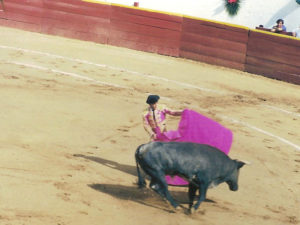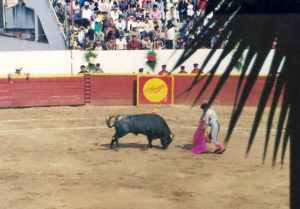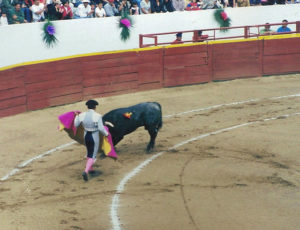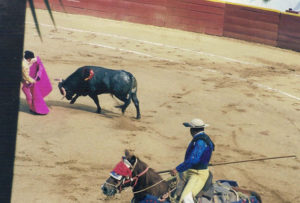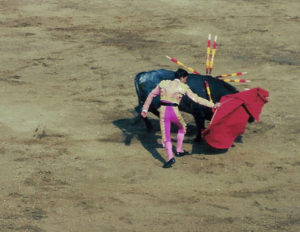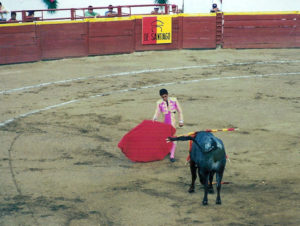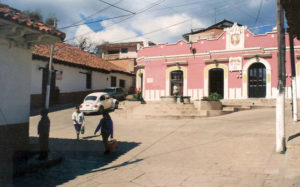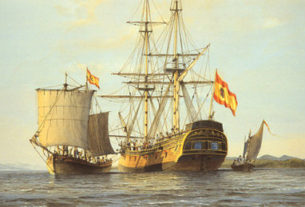From the outside, this bullring resembles nothing so much as a red erector-set construction but inside, it is a concrete-stepped cone funneling down to the sand, on which are painted two white rings, one inside the other. Entering the arena, your bags are searched to make sure there are no bottles to throw at the picadores, or so I think. The crowd winds through the darkened and arched galerías, past the dolls-house cathedral with its miniature stained-glass windows that is the chapel for the toreros, to climb the skeleton stairs flight after flight until it is my section and I am shuffled through the tunnel to emerge, borne into the light, my eyes momentarily protesting at the brilliance.
An old man sits beside me, alone and rigidly upright on the hot, still brightly-sunlit concrete Sombra (shade) tier. How he can sit there on the sun-heated concrete with his bony butt, is beyond me. At least I have rented one of the little plastic pillows that the kids have near the entrance. We are maybe one-third of the way up from the premier seats.
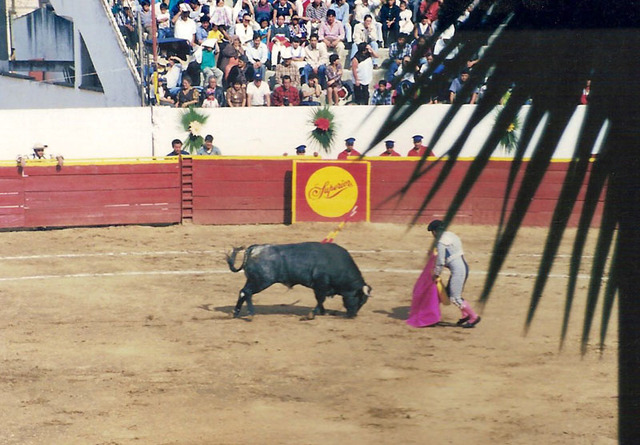
The velvet shadow is scything its way across the arena, but hasn’t quite reached us yet. A loudly-drunken Kansas orthodontic surgeon and his brittle-blonde trophy wife sit one tier below us, declaiming his ubermensch status to all and sundry.
For me, the show starts well before the 4 pm start of the corrida. The man beside me is an older man, maybe 70s or even 80s. A two or three day beard speckles his canyoned, shiny cheekbones; his nose is a scimitar blade, his eyes blue, white-clouded marbles with snow-capped ridges above.
His forehead is ridged and scarred on one side, but all in all, he exhibits a noble, dignified mien. He wears a spotless white shirt, the old-fashioned, collarless kind, open at the neck and showing a white-ribbed undershirt. His shiny black suit is old, but sponged clean and still showing traces of the knife-edged creases it had once borne, as well as the faint rust-colored signs of much wear.
He wears a matching neat, buttoned up vest, and his much-worn and creased shoes have been polished to almost-mirror brightness in spite of the old and cracked leather. A carefully brushed pearl-gray fedora with an old-fashioned wide silk-ribbon hat band sits squarely on his head, the brim raised all around.
The old man speaks English in a slow, precise, scholarly, almost pedantic, but halting fashion. When my attention is first attracted, he has already been somehow drawn to explain the proceedings to the dentist.
“Where’s the fuckin’ scoreboard?’ roars the slovenly dentist.
“¿Señor?” queries the elder.
“The scoreboard! The scoreboard! How ya gonna know who’s winning, Pancho?” The mouth mechanic’s wife cringes at his boorishness.
“Señor,” patiently explains the old man, “the bull never wins. The bull always dies. This is not about winning because the corrida is a ceremony of the death.”
“‘S’funny, thought this was a bullfight'” slurs the dentist.
“Not to aficionados, Señor. There is no such thing as a bullfight. We have come to think of it as a living work of art, and the torero is the artist. Yes, there is much blood, and horror too, if you must look at it that way, but we see the beauty, the approach to perfection. Music written in blood.”
It is easy it is to tell the turistas from the indígenas. The American tourists are loud, self-conscious and often drunk, and dress like panhandling street people except for their New Balances and their Vuarnets, while the Mexicans dress up to go to the corrida, or maybe they have just come from church.
While we are sitting there, all conversation in the section stops cold because this little teenaged chica struts lubriciously past, dressed in a skintight black torero outfit with a flat-topped sombrero cordobés perched prettily on her long hair at a jaunty angle. Her raccoon-shadowed flashing eyes echo the silver boot tips, belts, buckles and hatband which attract the eye to the silky fluidity and jingle besides, just in case you are blind.
There is nothing to identify her as Mexican, and she clearly thinks she is dressed in the latest American fashion… but she is not. It is a subtle but jarring difference. Too much makeup, too red lips, too dark eyeshadow, encarnadined dagger-like nails, an exaggerated sway to her walk… too much, too much. But fetching nevertheless….
The spectacle starts at sunset. so the sun will not be in the matador’s eyes as he faces the bull. The bullring is designed to give the matador the advantage.
Two horsemen in full regalia burst from the gate racing at top speed in opposite directions around the circumference of the ring until the crowd gasps at the coming collision, as they come together to stop in front of the box of the Presidente, to be given the key to begin. They return quickly to open the gate of the toriles for the grand procession.
They are the alguacilillos, the bailiffs who are the keepers of the gate.
The dentist cackles as the trumpet sounds the opening notes of the Paso Doble which mark the beginning of the event. “Lookit the fairies!” he points. The elderly man gives him a disdainful sniff.
They enter through the double red wooden gate, elegant and dignified as they stride across the ring toward the box of the Presidente in the paseillo, their passage, the procession of the cuadrillas. First come two matadores (surprise! There is no such thing as a toreador, or at least there wasn’t until the Opera Carmen appeared). Abreast, resplendent in their suits of light, the traje de luces, sparkling and winking in different colors. The colors are not important to the colorblind bulls, but the enhanced costumes are alive with the movement that will infuriate. Skintight, so there will be no folds of cloth for the horn to snag, the body of the torero is heavily oiled beneath, so that if the end of a horn does tear the suit, it might slide on the oil. A small protection, to be sure, but the matador wants every edge he can get, no matter how small.
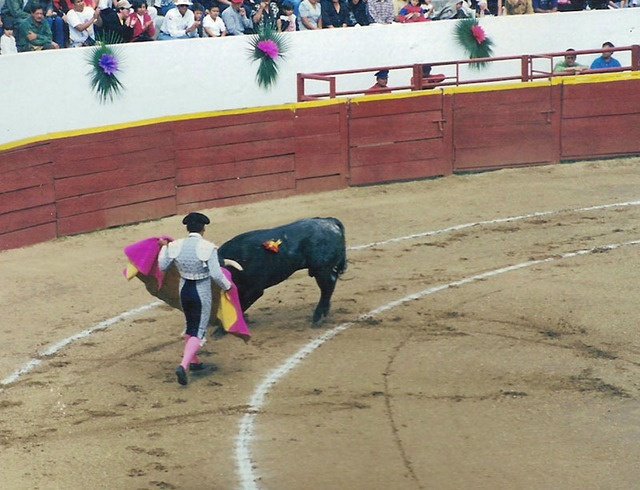
Because this is to be a corrida mixta, a mixed card, they are followed by the single somberly-clad rejoneador, in grey whipcord, rigidly erect and astride a splendidly-prancing white horse. After him come the peones, dressed like toreros but actually mere hangers-on. These are followed by the despised, hulking, picadores on horseback, then the brightly-clad banderilleros, and finally the mulillas, the men whose teams of mules will drag off the dead bulls.
They come to salute below the box of El Presidente.
Then they retreat, some of them remaining behind the barreras, the wooden, shoulder high barriers that are dotted about the circle.
A hush falls over the audience. Even the dentist seems to hold his breath, waiting, just waiting.
His name is Embajador and, weighing in at over 1,100 pounds (500 kilos), he is glossy black, huge and bulky in the front while his hindquarters are quick and agile. The horns are a flattened classic ‘U’ and the right one has a recently broken tip that leaves a sharp jagged weapon. The broken horn distresses the beast. The horns are related to a cat’s whiskers; they are needed to guide the bull, and suddenly one of them is missing, and the bull is angry and disoriented, not a good state for a bull to be in.
He is one of the six bulls that had been picked by the toreros’ representatives at the sorteo, the drawing of the bulls at noon on the day of the event. Two bulls are sorted for each of the matadores, and two for the rejoneador. It is sometimes called the apartado, the separation of the bulls, because after the sorting each bull is placed separately, together with several steers, in his own pen.
Embajador restlessly paces the small corral behind the ring, intimidating the steers that have been placed there to pacify him, leaving them to huddle against the rough wooden fence as the setting sun casts ever-longer shadows across the sand.
He is seven years old. Seven years of a sybaritic life, free to ramble and charge at anything that moves within his territory, bred to kill, from a long line of killer forebears, tested for courage, agility and speed to be a proper representative of the ganadería, the ranch where he has been bred. If he had been bred for meat, he would have experienced three years of a crowded and restricted life, restrained from running lest he lose some of his valuable fat before the terrified animal is pulled up by his hind feet and his throat slashed so that he can bleed out.
A little known fact is that there is always the possibility that the bull can leave the confrontation alive! A brave bull may be granted an indulto, a pardon by the President after petition by the crowd. The kill is then simulated by the matador with an empty hand and the bull becomes a stud, semental.
And even after death the bull may be granted the honor of being dragged around the ring by the mulillas in a triumphant circuit, a vuelta lap.
Embajador is cosseted into the chute by the steers, and a rosette divisa stuck onto his back, showing the colors of the ranch.
The sun is fading from powder-blue cloudlessness as the shadows creep across the circle. Liquid, brassy notes drift over the arena to sound the first tercio, the first fifteen minute third of the matador’s duel. A blackness bursts across the sand, a blacker shadow within a shadow, hooves booming a drumbeat in the sudden silence of 25,000 voices struck dumb by a power, by a living threat. The shrill giggle of a woman momentarily pierces the mood.
A wicked horn thunks into the red-painted barrera with a sound that reverberates throughout the arena.
A jagged wooden shard suddenly shows bone white, prised free with a toss of the nightmare head as Embajador wheels to continue his rampaging circuit of the sanded circle, seeking the territory he will choose to defend.
The watchers of the torero’s cuadrilla critically judge the moves and feints of the half-ton monster as it careens around the ring.
Every so often, one of the peones comes out from behind the barrera to taunt the bull, dodging agilely, all to see the character of the animal, and to draw him to different areas of the ring.
The crowd suddenly bristles as if it were some single, huge, prehistoric animal. Whistles and catcalls greet the lumbering entry of the two hated picadores, their horses caparisoned with heavily padded blankets, blindfolded so as not to bolt at the sight of the bull. The picadores are dully clad in brown, their legs protected by steel armor, their stolid, fleshy heads crowned by the steel, Saturn-like helms, and they carry the cruel picas, the lance with the puya, the steel head.
Their goal is to prod the muscle at the hump at the base of the neck so that the bull’s head is lowered to make the kill possible. It is not supposed to weaken the bull, and the crowd becomes quite vocal if the picador becomes too enthusiastic. Even so, the runnels of blood drip from the flanks to plop wetly onto the sand as a scarlet precursor to death.
While the picador is relatively safe, not so the horse, because the bull sometimes hooks a horn up under the blanket to endanger the unprotected underbelly. Horses are killed, horses are sometimes even upset and gored to death while the crowd is properly horrified.
But it is a fleeting event, and then the mulillas come in to drag off the dead horse, on its back, its legs comically extended, while the peones distract the bull.
They all retreat to leave the black monster standing alone, watching warily for what is to come next.
The Man on Foot
What comes next is the matador and he approaches with his tight-assed, pouter-pigeon walk, flaunting his coleto, the pigtail that is the professional mark of a torero who has taken his alternativa and is no longer a novillero. He calls to the bull, stopping to stamp his slippered foot to attract the attention of, the bull? The crowd? What draws my attention are his pink socks.
And the bull responds, turning to face the oncoming threat to his territory, snorting, pawing, throwing up sprays of sand as he prepares to charge. But this is not the real thing, not yet, and it is only the torero testing the bull, flourishing his large capote, the purple and yellow cape, or maybe it is the bull testing the torero. There are some passes, it is the time of the showy veronicas, and some olés! olés! from the spectators, but mainly it is for the education of the matador.
Unfortunately, the bull learns as well. Some think the bull brutishly stupid when nothing could be further from the truth. Bulls are so intelligent that they can only be challenged once and then must be killed because they learn so fast that they would be too dangerous for any torero.
It is trickery that kills the bull. Misled from the true target by fluttering capes.
The trumpet sounds again. It is time for the second tercio. The tercio of the banderilleros.
Embajador stands as if planted in the sand, alone, exhausted by his charges and confrontations with the picadores, visibly panting, his flanks heaving, abandoned by the matador who disappears behind a barrera.
They come. Suddenly materializing in the ring. The brightly dressed banderilleros, the three toreros who are part of the cuadrillo of their matador. They are there to energize the exhausted, still bleeding bull for the final act. Antagonize him, frustrate him and make him angry.
They come at him one at a time, waving their brightly-colored banderillas, the long, barbed sticks that are to be planted in the bull’s hump, two sticks at a time, one run for each of the banderilleros. Sometimes they are brave, challenging the huge animal and going in close with a graceful arching of the body, to cleanly plant the sticks. Sometimes they are tentative, terrified of the monster, wanting only to do what they have to do and get away as quickly as possible. Wouldn’t you be? Failing to plant the barbs deeply, the sticks sometimes fall out as the bull trots the ring.
And all the time the band is playing. “Musica Taurina,” “La Virgen de la Macarena,” “Silvio Perez,” “El Dos Negros,” and many of the popular tunes, the infectious silvery notes falling and bouncing around the arena.
This matador has chosen not to place his own banderillas, as he is allowed to do, demonstrating his skill and bravery. Sometimes a matador will break the sticks in half, planting the short banderillas closer to the bull. The great Spanish matador Manolete would break the sticks off pencil-size, and wow the crowd. Not surprisingly, Manolete died on the horns.
Finally, the trumpet sounds once more, and it is the time of the third and final tercio, the suerte suprema, the time of the faena and the estoque, the avisos. And too, the time of the puntillero.
The lead or senior matador is Pedro de Parilla, nicknamed El Tapatio because his home town is Guadalajara. He strides to the box of El Presidente and doffs his montera, asking permission to kill the bull. The Presidente waves his white handkerchief to give permission. El Tapatio turns and offers a brindis, a salute to a stunning young woman in the front rows, throwing her the montera backward over his shoulder as she smiles, standing and stretching gracefully to catch it high in the air, all to the cheers and applause of the crowd.
This is the final act, and the crowd settles down with a critical eye, awaiting the artistry of the matador, his melding with the bull so that they become one in an almost sexual blending. This final act requires a supernatural ability of the matador to judge and anticipate the moods and moves of his bull.
For the faena, the matador eschews the huge capote for the smaller, red flannel muleta draped over a short stick. It is here that he shows his skill and his bravery with the veronicas, pases de pecho, remate de tanda. Porto gayola and the trinchera, all death-defying capings ever closer to the horns and the blood-flecked flanks, and performed almost in the face of the turning, charging and spinning animal, again and again, the huge head tossing, the horns sliding against the deceptive solidity of the cape, until finally the bull stands rooted to the spot in exhausted confusion.
Now El Tapatio can show what he is made of. A lone man, alone with the black monster on the sand. No hiding place. No escape. Taunting, calling, cajoling, disdaining, turning his back, walking away, then returning to touch the bulls nose and even the top of his head.
The exhibition goes on for ten minutes, and then the first trumpeted aviso, the first warning, sounds. Now is the time for El Tapatio to exchange the stick for the estoque, the short, thirty-three inch sword, the killing blade. The target for the matador is a small soft spot at the base of the bull’s hump, where the sword can penetrate directly to the heart of the bull, dropping him like a rock.
The best way, maybe even the only way to do it properly, is for the bull to stand stock still and upright while the torero takes a stance about eight feet from the nose of the bull, points the estoque at the ‘sweet spot’, then takes a short run, going over and between the horns in a single daring thrust, graceful, brave, and possibly even foolhardy.
But enough of fantasy. Now consider the realities. In front of the matador is a half-ton of wild, killing animal, unlikely to stay still while the hated man, stripped now of the concealing muleta or capote, is open to a direct, or even an indirect attack. The bull may decide to run at the torero, and again he may decide to hook his horns at the last minute, impaling the helpless man, then flinging him aside, a broken bag of blood. Many matadors have died just this way. It isn’t always just the bull that dies.
The bull is statue-still. El Tapatio points the estoque and begins his run, going in over the horns with what looks like a perfect thrust. But the sword misses, bending almost double as it strikes bone with the force of the matador’s arm behind it. Torn from his surprised grasp, the sword springs high into the air to fall on the other side of the animal as the crowd gasps.
The peones swiftly appear, waving capes to distract the suddenly energized bull, turning and spinning, from the disarmed matador. Meanwhile, another estoque is brought out to him as the bent and fallen sword is whisked away.
The peones unfold their concealing capes, and disappear to leave Embajador standing, warily eyeing the again approaching man, in a replay of the killing tableau. But this time the bull isn’t playing, and he charges, sending the surprised matador scurrying behind the barrera to the catcalls of the crowd, as a horn thunks into the thick wood and the bull snorts and paws around the barrera, seeking the missing man.
El Tapatio waits until the bull has settled down, but then three minutes after the first warning, the second aviso sounds, the second warning. The third aviso would be sounded in only two more minutes, and it will signal an end to the event. The bull will live, and be led off, and it will be a terrible stain on the matador’s reputation.
Emerging from his hiding place behind the barrera, El Tapatio approaches the beast to begin the faena again. After a few desultory charges and lackluster passes, the exhausted bull finally assumes the killing tableau with the matador, and this time El Tapatio goes in straight over the horns and the sword goes home true. Immediately Emperador drops onto his front knees and then rolls over on his side. Cheers and shouts of olé accompany El Tapatio as he raises his hands and grins at the stands.
Then there is an amazed ‘Oh’ from the stands. The puntillero, ‘tacker’ had scuttled out with his short, sharp razor-sharp knife to cut the bull’s spinal chord, the coup de grace, but as he begins his surgical insertion, the cut awakens the bull, and he rises howling and scrambling to his feet, the matador falls back, and the peones again appear. This time they successively cape the bull, so that he is spinning, spinning and turning, until he just runs out of life and crashes heavily to the ground, churning up a cloud of dust.
The relieved matador again raises his hands and grins to receive the plaudits of the throng, but this time he is met mostly with silence, with only a scattering of catcalls and whistles.
There are no trofeos awarded by El Presidente for this shameful performance. No ears and no tail to be held high by the matador as he and his cuadrillo circle the ring to the rousing applause of his fans, throwing botas, brassieres, and seat cushions at them.
The mulillas whip their mules to drag away the carcass, leaving a trail of blood.
The bulls enter the ring so alive, and they leave so dead.
The Man on Horseback
Each of the matadors, or in this case two matadors and one rejoneador, has chosen two bulls, two chances to kill or be killed, and the sequence is much the same, but the rejoneador accomplishes it differently.
The bull this time is Impulsivo, a larger bull, maybe 1,500 pounds (650 kilos), and younger, only five years old. He explodes from the gate of the toriles running full out, the white star on his forehead swinging from side to side. Searching out his territory and an enemy. Any enemy.
The peones oblige, darting out for a few passes, then ducking back for another peon to appear on the other side of the ring, drawing the bull out to see how he moves, how brave he is, his strong points and weak points… The rejoneador sits tall and rigidly upright on his magnificent chestnut stallion Aldebaran, watching eagle-eyed from behind and over the closed gate. He is close-clad in a beautifully cut gray whipcord suit, called the traje corto andalusia from the place where it originated, and he wears the traditional flat-topped black hat, the sombrero cordobés, square upon his head, the insolent pigtail clearly showing underneath.
Wavy jet-black hair and aristocratically Spanish features belie the 44 years and more than 50 corridas of Juan Hermoso de Valenciana.
Man and mount together. His roan Aldebaran is only one of the four superb thoroughbreds that are the real stars of the show. Still to be seen are; the ebony Mazzantini, white flowers entwined in his mane, white star on his forehead dripping down onto his muzzle; the dazzlingly white Chicuelo, his mane sporting black flowers; and the crowd favorite, Cagancho, a huge dapple gray horse, stolid and phlegmatic. Each of them has been painstakingly trained together with their rider to perform one of the very distinct acts leading to the inevitable taurine death, but to do it in an exhibition of flawless horsemanship, of prancing, bowing and breathtaking leaps.
The rejoneador is a very different kind of torero. Not for him the brilliance of the suit of lights, or the massive implacable looming of the hated picadores. No, this is the elegant lightness of a man as a prancing equestrian against this primordial monstrosity. The order of events is the same, and the only differences are that all is exquisitely performed on horseback, the rejoneador does not use the picadors, no capes are used, the banderilleras are longer and placed by the torero from horseback, and the estoque is replaced by a killing spear.
He fights in the old way, in the way the kings sported, from the days of King Carlos — in the style of Portugese cavaleiros.
He is closely watched by a gathering of knowledgeable aficionados. These are the old men from the cities and the harsh plains, and are not put off by the blood or the brutality, but instead entranced by a ballet of courage and grace in a pas de deux with brute energy.
Color and light and sound flood the senses. Mexico has always been a land of harsh sun and primary colors, mostly startling reds and vibrant yellows. The sky is the bluest of pale blues. Sand sparkles as it waits for the blood and the blackest shadows hint of the underworld. The billboards dominate and are ever-present. Even here they must render unto Caesar. It is the vibrant red and white of Coca-Cola, and the yellow and black Cerveza Dos Equis, but repeated over and over.
Although rhythmic Indian music and popular tunes compete to inspire dancing among the waiting crowds outside the Plaza de Toros, they give way to liquid trumpet tones, rolling drumbeats and fat German tubas inside. Inspirational music, stirring, even heroic. A rollicking popular tune of the day as interpreted by the distinctive stringless band bounces and echoes around and off the hard concrete, seemingly unmuffled by the myriad bodies. Latin music, reminiscent of the softer colors of the evening played out here against the harsher backdrop of sunsplashed Mexico.
Cries of the hawkers of botas, wineskins, and the omnipresent Coca-Cola as well as cacahuates, tamales and faux bullfight paraphenalia annoy as they dance nimbly along the tiers threading their way through and over feet and ankles.
Impulsivo returns to his territory after successfully driving off the invading peones, waiting warily for the next attempt, suspiciously eyeing the entry of the man on horseback as he moves into the arena to approach.
Fresh from his recent triumphs, the bull moves out to confront this new antagonist and almost immediately charges, trying to attack the horse as it tantalizingly stays just out of reach, but Impulsivo is confused by the flags, or by the tantalizing tail of the horse, and then, when he knows better, by the false vitality of a blue and white banner that the rejoneador trails and the bull chases. The art is in keeping the horse just away from those seeking horns.
It’s easy to ridicule the art of the man on the horse. Easy to say that it is the horse that is most in danger and that, as opposed to the matador on foot, the rejoneador has interposed the horse between himself and the terror.
That would be wrong, for as this drama of death plays itself out, it clear that the man and the horse have joined and that the danger to the horse has also become the danger to the man.
Cagancho prances sideways across the ring under the masterful hand of the rejoneador, each mincing step precise and sure, while Impulsivo again stands guard over the patch of sand that he has marked out as his own.
That is the wonder of the rejoneador, the complete marriage of the horse and rider so they become one, so that Cagancho can respond instantly to Juan’s bidding. The man the brain, the horse the body. The prancing may seem effete, but instead it is an exhibition, proof to the spectators that they are an entity capable of challenging this throwback to another, more primitive time.
The bull seems a monstrous, implacable, irresistible destroyer. A force of nature that can never be withstood.
But that would be false, for it is the rejoneador that is the implacable force, that has decreed the time, the place, and the manner of death for the animal. And the bull? He is but a dull and bewildered plaything for the game at hand.
The crowd stamps and whistles at the performance, but is restless, a living, breathing, sentient thing waiting for the preliminaries to be over and the main event to begin.
The rejoneador deliberately edges his mount into the zone that the bull has marked for his territory, and so begins the dance. Impulsivo shifts himself to face the incursion, snuffling, snorting and then pawing the ground, tossing gouts of sand and dust behind him. Juan looses the reins, guiding Cagancho only by the gentle pressure of his knees against the horse’s withers as they proudly approach the waiting animal. In his right hand Juan grips the wooden shaft of the rejón de castigo, the punishment spear, a five foot lance with the six inch, leaf-shaped tempered head. This takes the place of the brutal picadors.
The bull lowers his head and charges, arrow-straight at the slow-moving man on horseback. A gentle nudge aims Cagancho like a bullet from a gun at the oncoming creature of darkness. In seconds the horse is thundering to meet Impulsivo. At the last second the horse pulls up short and the man leans over to plunge the blade into the great animal’s bunched neck muscle. The crack of the shaft breaking off the blade echoes throughout the stone tiers, leaving the sharpened edges of the iron weapon to saw at flesh and sinew with each movement, and lines of dark blood course down the sleek black sides, to trail onto the sand as Cagancho spins, taking Juan from harm’s way and out of the ring.
Again the trumpet sounds, and it is the second tercio. De Valenciana gallops out of the gate and then stops stock still so that the elegant black Mazzantini can execute a perfect bow to the delight of the crowd. The intense duet continues as the rejoneador places the special long banderilleras in a breathtaking display of horsemanship.
As always, it is the third tercio that is the climax, with the horseman wielding the rejón de muerte, a lance to kill the bull. It is a feat that some say takes even more skill to hit the right place than that of the matador on the ground. For the rejoneador, the bull and the horse are moving when the spear is placed.
Whether matadores or rejoneadores, the corrida ends the same way. Everyone who has rented the little vari-colored plastic seat pillows, sails them down into the ring, and children come out to pick them up as the crowd exits the arena.
An exhibition of skill, any skill, is always more interesting when you know what is really going on. I hope the Dentist reads this.

